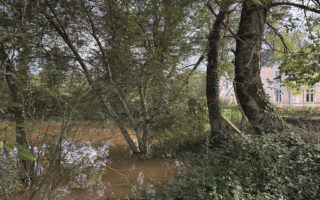10 things that may surprise you about life in rural France

Bought yourself a dream home in the French countryside? Our countryside columnist Jeremy Hobson reveals some of the surprises that may lie in store for you

1. Dandelions are just dandy
They may be unpopular in Britain, but in France the humble dandelion is not always considered a weed. Their peppery leaves, similar to rocket, are often used in salads, especially in spring when they are at their sweetest.
High in fibre, vitamins and minerals, dandelions are also beneficial to chickens and some breeders actually grow them to feed to their flocks. It’s said the roots are a great liver tonic, and some breeders grind up the tap roots so as to add the resultant powder to their chickens’ feed during winter.
Of course the word ‘dandelion’ comes from the French dent de lion (lion’s teeth), a reference to their spiky leaves, though the French call them pissenlits (wet the beds) in reference to the diuretic effect of their roots.

2. There are some big rodents
You may come across coypu (ragondin in French) a large semi-aquatic rodent that lives in burrows in the banks of lakes and rivers and is considered an invasive pest. Originally from South America, they were introduced to Europe many years ago for their fur, but are thought to have been eradicated from the UK.
Called Myocaster coypus in Latin, meaning beaver rat, they can damage farmland crops bordering waterways. There has been at least one fatality when a farmworker, driving a tractor, drowned while tilling a field after his machine tipped over into the river due to coypu-created subsidence. If you come across them contact your mairie.

3. Hunting is a big thing
More than a million people practise hunting in France. French hunters have (or should have) passed theory and practical tests before being given the appropriate licencing to go out game shooting. As well as safety aspects, the tests also include quarry recognition. There are also certain rules and conditions regarding how close to property they can shoot – and whose land they can or cannot pass over.
The game shooting season generally begins in September and ends in February but the actual dates vary depending on individual departments. To find out more on the legalities in your area, visit the regional prefecture or even your local mairie; either of which should be able to answer your questions. It is probably better to speak directly to them rather than friends or neighbours’ – who may well have preconceived and possibly erroneous information to impart.
4. The elixir of life is potentially lethal
Your neighbours may welcome you with a bottle of homemade eau de vie, an extremely potent colourless alcoholic drink. Despite its name (water of life) it’s not meant to be drunk on its own unless you have a death wish! To make it drinkable, you could add sloes or damsons, leave it for six months, ‘dilute’ with red wine and give it another two years, siphoning off the residue occasionally and having an occasional taste.
Commercially-produced eau de vie is the same strength as a good whisky or gin and, even though colourless, is often already flavoured with summer fruits.
5. Berets are still beret good
Flat caps similar to those associated with Yorkshire are more commonly worn nowadays, but you may see men in the French countryside wearing berets, especially older folk and people at traditional rural events. The iconic hats were originally worn by shepherds in the Pyrénées who used wool from their sheep and the mountain waters to make a hard-wearing, relatively water-resistant felt. Farmers, general labourers, the military and anyone who worked regularly outdoors soon adopted the head covering and eventually it became fashionable among artists and women too. Laulhère in Oloron-Ste-Marie, in the Béarn province, is arguably the best-known beret manufacturer.
_________________________________________________________________
Don’t miss
How to bake in an old French bread oven
This renovated farmhouse in rural France attracts guests from across the world
Hold your nose! France’s five stinkiest cheeses
________________________________________________________________
6. There are wolves in wolves’ clothing
There are some 360 wolves in France, distributed among 24 departments, and their number is set to increase to 500 by 2023, but it’s very unlikely that you will encounter one as they are far more likely to slip away at detecting your presence than face a stand-off. The animals are protected but are causing some consternation to some sheep farmers.
Currently, hunters are allowed to cull about 10% of the local wolf population every year and this could rise if attacks on livestock become more frequent.
7. There’s an official day for planting trees
There’s a tradition in France that trees should be planted on Saint Catherine’s Day, on 25 November.
If you’ve missed the optimum date, however, rest assured that trees planted between October and April should be fine, as long as you avoid putting them in waterlogged or frozen soil, loosen the soil and incorporate organic matter around (not under) the rootball, water in, stake if necessary, consider using a mulch mat to keep the immediate area weed-free, and then water regularly (especially in dry weather) until the tree is established.
8. Various creatures may set up camp in the attic
Hear the pitter patter of tiny feet in your loft? It could be mice or rats but alternatively it could be edible dormice or stone martens, two creatures you wouldn’t expect to see in the UK.
The edible dormouse (loir) is widespread in France, except the far north and west, and is quite cute-looking with bushy tail and dark rings around the eyes. It sometimes sets up camp in a house in the early autumn and, like mice, can do damage by chewing wiring, though it’s unclear if this would happen with modern wiring. It tends to hibernate from about October until April.
Stone martens, also known as beech martens, are called fouines in French and are quite common across rural France. They too seem to like munching at loft insulation material and electric cables. Easier said than done but try and block any potential entry holes seen near the roof with chicken wire or similar as once they’ve taken up residency, they are difficult to evict!
9. They have big frogs
Marsh frogs (Pelophylax ridibundus) are arguably the largest of the frog types likely to be found in France. It’s probably the commonest too and can survive well in water conditions (pollution from road run-off; ponds and lakes containing large fish stocks, for instance…) where others cannot. They hibernate in or near water and, as is the case with most other amphibians, breeding takes place in the spring – with the males calling to attract a mate. It’s supposedly the type of frog most usually associated with the French culinary delicacy of ‘frog’s legs’!
For those unsure of how best to differentiate between frog and toad; basically, frogs have smooth, slimy-looking skins, whereas toads are squatter and have dry, ‘warty’-looking skin. Also, if it hops when moving, it’s likely to be a frog but, if it crawls, it’s generally a toad!
10. It’s virtually impossible to have a Dryanuary in Burgundy
On January 22, it’s the feast day of Saint Vincent, patron saint of winemakers, who is particularly venerated in Burgundy. In wine villages across the region, brotherhoods parade through the streets carrying banners, flags and an effigy of the martyr to give thanks for the previous harvest. Of course there are plenty of opportunities to sample the local tipples, although the old days of limitless free booze seem to be over.
Footnote
If there is one book that will help newcomers to France with the language and gardening, it’s the Glossary of Gardening and Horticultural Terms by Alan S Lindsey, published by Hadley Pager.
Jeremy Hobson is the author of over 30 published books and a regular writer for many of the UK’s field sports, farming and rural-based magazines. Having lived in France for many years – and thoroughly immersing himself in French rural living – he is the compiler of the popular monthly Rural Riddles column for French Property News.
Share to: Facebook Twitter LinkedIn Email


